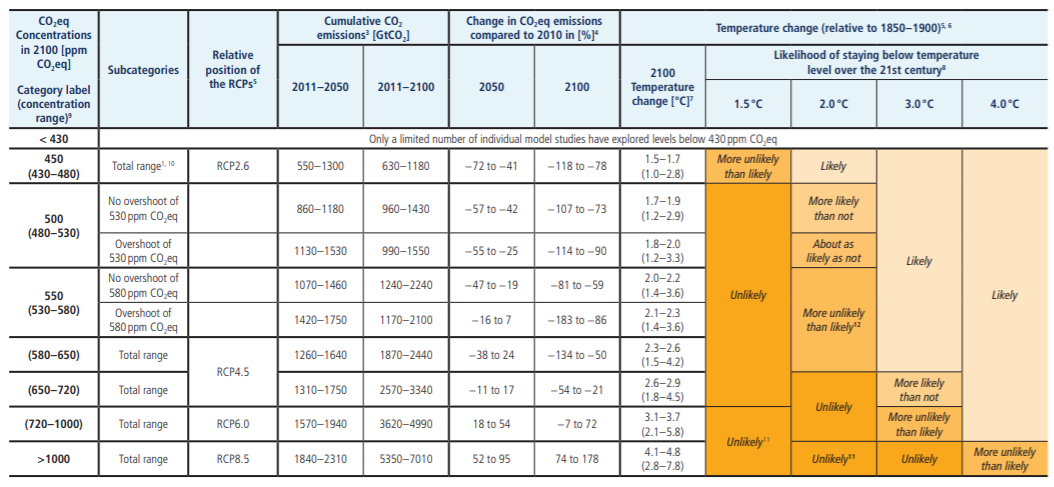In this series of blog posts I will discuss some of the assigned readings for the Sustainable Planning Seminar (Urban Planning/Geography/Landscape Architecture 446) at the University of Illinois at Urbana-Champaign (UIUC). The readings for this week are:
- IPCC “Summary for Policy Makers”
- Fourth National Climate Assessment (summary only)
- Selected chapters from David Orr’s book, Hope is an Imperative.
Summaries
IPCC “Summary for Policy Makers”
Since this document is itself a summary of a much longer report I won’t summarize every conclusion they make here. Instead I’ll highlight a few of the items that I found particularly interesting.
- Combined cycle natural gas plants may be an important technology to transition away from coal-fired plants.
- Successful mitigation strategies will require changes in end-use demand, not just changes in energy supply.
- The building sector accounted for almost a third of final energy use. This is surprisingly low. I have seen other reports indicating that building energy use is almost two thirds. This is possibly only true in the United States, though.
This figure summarizes the main findings of the report. It’s frightening that even if the strongest mitigation strategies were adopted, it is “more unlikely than likely” that the Earth will stay below 1.5°C above pre-industrial levels.

Fourth National Climate Assessment
This report gives a detailed state-of-the-climate for the United States. Consistent with IPCC findings, the United States is not doing enough to mitigate climate change. I was impressed by the breadth of its summary findings. I was particularly impressed that there was a section dedicated to the impacts of climate change on indigenous peoples. The section on mitigation strategies was quite short, although the purpose of this document wasn’t to evaluate all possible avenues, but to catalog the changes and impacts caused by the climate crisis. This makes sense because the climate impacts are myriad. Combined with the IPCC report, the picture of the future looks very grim.
David Orr: “The Carbon Connection”
This is a chapter (or perhaps an essay) from David Orr’s book Hope is an Imperative. In it, he shares vivid descriptions of the damage in Louisiana after Katrina; small land-owners in North Carolina struggling to keep their property free from coal mining; and coal companies that couldn’t care less about how their actions impact the climate. The connection is carbon, he says. The climate is not only being damaged as a side-effect of CO2 emissions, but also by humans actively destroying nature to secure energy resources.
David Orr: “2020: A Proposal”
First published: 2000
Orr once again describes the dire situation presented by climate change. He makes a bold analogy, comparing society’s dependence on fossil fuels to slavery. His claim is that we are mortgaging the futures of subsequent generations. The eponymous “2020 proposal” is for all universities and schools to adopt aggressive policies to abolish fossil fuel usage by 2020. This work is prescient.
Synthesis
Taken together, all of these readings create a portrait of our current climate crisis. The National Climate Assessment (U.S.) explicitly describes what effects are already being felt, where, and by whom. The IPCC report makes technical recommendations that could prevent further warming, and thus reduce environmental harm. David Orr’s essays give a more human dimension to the problem by introducing people from different parts of the United States. His chapter on the proposal to reduce fossil fuels on university campuses was certainly farsighted and important. The 2020 proposal preceded the first Illinois Climate Action Plan (iCAP) by a decade and was far more aggressive than that first plan by UIUC. I don’t have any deep or insightful comments about the technical reports. I largely agree with Orr’s assessment that human activity is destroying natural places, habitats, and ecosystems for myopic reasons. However, his suggestions for replacing our coal energy trivialized an immensely challenging problem. He mentions in “Carbon Connection” that we have enough energy resources from renewables to get off of coal (if only it weren’t for those greedy coal companies). His recommendation to universities was to “[develop] plans to harness renewable energy sources sufficient to meet campus energy needs by 2020.” Followed by “ competent implementation.” I won’t go into detail here, since I have written and presented about the UIUC energy system elsewhere. But renewables are absolutely not enough by themselves.
- The campus is heated by direct steam from Abbott Power Plant, not electricity.
- Producing that heat from renewable sources is incredibly inefficient.
- Up to 60% of campus electricity demand is imported from the MISO grid at any one time. This is accounts for the majority of campus emissions.
It’s a big problem and there is no magic bullet.
Media and Further Reading
DECC 2050 Calculator
For readers curious about what actually needs to go into a successful mitigation strategy, I encourage you to check out the DECC 2050 Calculator. This tool gives a good high level view of the problem scale. It also offers more detailed explanations for each assumption that went into the model.
Illinois Climate Action Plan
Read about UIUC’s plan to decarbonize by 2050 here.
Illinois Utilities and Production Master Plan
For especially curious and detail oriented readers, you can read the comprehensive report on energy production and usage from the UIUC Facilities and Services Department, here.